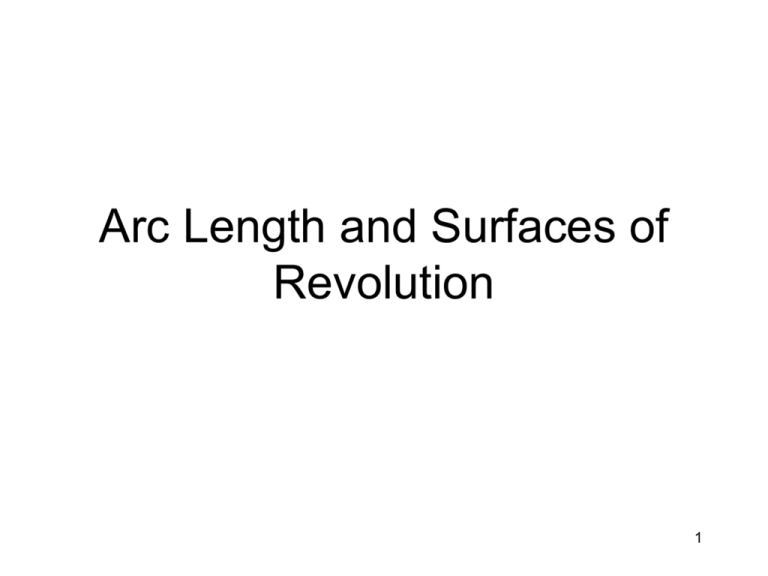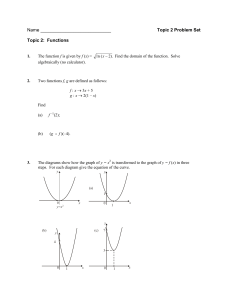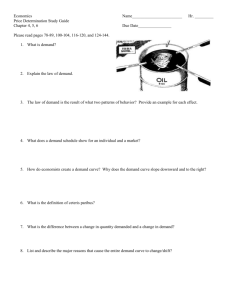Arc Length and Surfaces of Revolution
advertisement

Arc Length and Surfaces of Revolution 1 Arc Length for y = f(x) Suppose a curve is given by y = f(x), where f is a function with a continuous first derivative on the interval [a, b]. The goal is to determine how far one would travel if one walked along the curve from (a, f(a)) to (b, f(b)). This distance is the arc length, which we denote as L. As shown in the figure on the next slide, we divide [a, b] into n subintervals of length ∆x = (b - a)/n, where xk is the right endpoint of the kth subinterval, for k = 1,…,n. Joining the corresponding points on the curve by line segments, we obtain a polygonal line with n line segments. 2 If n is large and ∆x is small, the length of the polygonal line is a good approximation to the length of the actual curve. The strategy is to find the length of the polygonal line and then let n increase, while ∆x goes to zero, to get the exact length of the curve. 3 Consider the kth subinterval [xk-1, xk] and the line segment between the points (xk-1, f(xk-1)) and (xk, f(xk)). We let the change in the y-coordinate between these points be y k f x k f x k1. The kth line segment is the hypotenuse of a right triangle with sides of length ∆x and |∆yk| = |f(xk) - f(xk-1)|. The lengthof each line segment is x 2 2 y k ,k 1,2,...,n. Summing these lengths, we obtain the length of the polygonal line, which approximates the length L of the curve n L k1 x 2 2 y k . 4 In previous applications of the integral, we would, at this point, take the limit as n ∞ and ∆x 0 to obtain a definite integral. However, due to the presence of the ∆yk term, we must complete one additional step before taking a limit. Notice the slope of the line segment on the kth subinterval is ∆yk/ ∆x (rise over run). By the Mean Value Theorem, this slope equals f ´(xk*) for some point xk* on the kth subinterval. Therefore n L x y k 2 2 k1 n k1 y 2 2. 2 k Factor out (∆x) x 1 y 5 n k1 2 y k 1 x y n 1 f x x. * 2 k Bring ∆x out of the square root. Mean Value Theorem k1 Now we have a Riemann sum. As n increases and as ∆x approaches zero, the sum approaches a definite integral, which is also the exact length of the curve. We have n L lim 1 f x n k1 x * 2 k b 1 f (x) 2 dx. a 6 Note: 1 + f´(x)2 is positive, so the square root in the integrand is defined whenever f´ exists. To ensure √(1 + f´(x)2) is integrable on [a, b], we require f´ to be continuous. 7 Example 1: Find the length of the curve f(x) = x3/2 between x = 0 and x = 4. Notice f´(x) = (3/2)x1/2, which is continuous on the interval [0, 4]. Using the arc length formula, we have…. 8 L b 1 f (x) 2 dx a 3 12 2 1 x dx 2 4 0 4 9 1 xdx 4 0 4 9 Substitute for f´(x). Simplify. 10 udu u = 1 + (9/4)x, du = (9/4) dx 1 10 4 2 3 2 u 9 3 1 8 3 2 10 1 27 9.1 units. Fundamental Theorem Simplify. 9 Example 2: Find the length of the curve f(x) = x3 + 1/(12x) on the interval [1/2, 2]. We first calculate f´(x) = 3x2 - 1/(12x2) and f´(x)2 = 9x4 (1/2) + 1/(144x4). The length of the curve on [1/2, 2] is L 2 1 1 f (x) dx 2 2 1 2 2 1 2 2 4 1 1 1 9x dx 4 2 144 x 2 2 1 dx 3x 2 12x 2 1 3x dx 2 12x 1 2 2 Substitute. Factor. Simplify. 2 3 1 x 8. 12x 1 2 Evaluate the integral. 10 Example 3: Consider the segment of the parabola f(x) = x2 on the interval [0, 2]. a. Write the integral for the length of the curve. Noting that f´(x) = 2x, the arc length integral is 2 2 1 f (x) 2 dx 0 1 4 x 2 dx. 0 b. Use a calculator to evaluate the integral. 2 1 4 x 2 dx 4.647. 0 11 Note: When using technology, it is a good idea to check whether an answer is plausible. We found the arc length of y = x2 on [0, 2] is approximately 4.647. The straight-line distance between (0, 0) and (2, 4) is √20 ≈ 4.472, so our answer is reasonable. Arc Length for x = g(y) Sometimes it is advantageous to describe a curve as a function of y, that is, x = g(y). The arc length formula in this case is derived exactly as in the case of y = f(x), switching the roles of x and y. The result is the following arc length formula. 12 Example 4: Find the length of the curve y = f(x) = x2/3 between x = 0 and x = 8. 13 The derivative of f(x) = x2/3 is f´(x) = (2/3)x-1/3, which is undefined at x = 0. Therefore, the arc length formula with respect to x cannot be used, yet the curve certainly appears to have a well-defined length. The key is to describe the curve with y as the independent variable. Solving y = x2/3 for x, we have x = g(y) = y3/2. Notice when x = 8, y = 82/3 = 4, which says we should use the positive branch of y3/2. Therefore, finding the length of the curve y = f(x) = x2/3 from x = 0 to x = 8 is equivalent to finding the length of the curve x = g(y) = y3/2 from y = 0 to y = 4. This is precisely the problem solved in Example 1. 14 Example 5: A climber anchors a rope at two points of equal height, separated by a distance of 100 feet, in order to perform a Tyrolean traverse. The rope follows the catenary f(x) = 200 cosh(x/200) over the interval [-50, 50]. Find the length of the rope between the two anchor points. 15 Note that f´(x) = 200 sinh(x/200)(1/200) = sinh(x/200). Therefore, the length of the rope is L 50 50 50 2 x 1 sinh dx 200 2 0 x 1 sinh dx 200 2 Arc length formula. Use symmetry. Let u = x/200, the 400 du = dx. u(0) = 0 and u(50) = 1/4. 1 4 400 1 sinh 2 udu 0 We know that 1 + sinh2 u = cosh2 u. So….. 16 1 4 400 cosh udu 0 1 4 400sinh u 0 1 400sinh sinh 0 4 ≈ 101 feet. 17 Area of a Surface of Revolution The area of a surface of revolution is derived from the formula for the lateral surface area of the frustum of a right circular cone. 18 Area of a Surface of Revolution Consider the line segment in Figure 7.43, where L is the length of the line segment, r1 is the radius at the left end of the line segment, and r2 is the radius at the right end of the line segment. Figure 7.43 19 Area of a Surface of Revolution When the line segment is revolved about its axis of revolution, it forms a frustum of a right circular cone, with Lateral surface area of frustum S = 2 rL where Average radius of frustum 20 Area of a Surface of Revolution Suppose the graph of a function f, having a continuous derivative on the interval [a, b], is revolved about the x-axis to form a surface of revolution, as shown in Figure 7.44. Figure 7.44 21 Area of a Surface of Revolution Let be a partition of [a, b], with subintervals of width xi. Then the line segment of length generates a frustum of a cone. Let ri be the average radius of this frustum. By the Intermediate Value Theorem, a point di exists (in the i th subinterval) such that ri = f (di). The lateral surface area Si of the frustum is 22 Area of a Surface of Revolution By the Mean Value Theorem, a point ci exists in (xi – 1, xi ) such that So, and the total surface area can be approximated by 23 Area of a Surface of Revolution It can be shown that the limit of the right side as is In a similar manner, if the graph of f is revolved about the y-axis, then S is 24 Area of a Surface of Revolution In these two formulas for S, you can regard the products 2 f (x) and 2 x as the circumferences of the circles traced by a point (x, y) on the graph of f as it is revolved about the x-axis and the y-axis (Figure 7.45). In one case the radius is r = f (x), and in the other case the radius is r = x. Figure 7.45 25 Area of a Surface of Revolution 26 Example 6: The graph of f(x) = 2√x on the interval [1, 3] is revolved about the x-axis. What is the area of the surface generated? 27 Noting that f´(x) = 1/√x, the surface area formula gives S b 2 2 f (x) 1 f (x) dx a 3 1 2 2 x 1 dx x 1 4 x 1dx 1 3 3 8 x 1 3 2 16 4 2 3 3 1 ≈ 43.325 28 Example 7: The curve y = √(4 - x2), on [-1, 1], is an arc of the circle x2 + y2 = 4. Find the area of the surface obtained by rotating this arc about the x-axis. (The surface is a portion of a sphere of radius 2). 29 Note that 1 dy 1 x 2 2 4 x 2x dx 2 4 x2 S b 2 2 f (x) 1 f (x) dx a 2 1 4x 2 4x 2 1 2 1 1 1 x2 1 dx 2 4x 2 4x 2 dx 4 1dx 1 4 (2) 8 30 Example 8: The arc of the parabola y = x2 from (1, 1) to (2, 4) is rotated about the y-axis. Find the area of the resulting surface. 31 dx 1 dy 2 y x y and Using S 2 d r(y) 1 r(y) dy 2 2 c we have 4 1 4 1 y 1 dy 4y 4 y 1dy 1 4 17 u du where u = 1 + 4y 5 17 6 17 5 5 ≈ 30.846 32 Example 9: The curved surface of a funnel is generated by revolving the graph of y = f(x) = x3 + 1/(12x) on the interval [1, 2] about the x-axis. Approximately what volume of paint is needed to cover the outside of the funnel with a layer of paint 0.05 cm thick? Assume x and y are measured in centimeters. 33 Note f´(x) = 3x2 - 1/(12x2). Therefore, the surface area of the funnel in cm2 is S 2 b f (x) 1 f (x) 2 dx a 2 3 2 1 1 2 x dx 1 3x 2 12x 12x 1 2 1 2 x 3 12x 1 2 2 2 1 dx 3x 2 12x 1 2 1 2 x 3 3x dx 2 12x 12x 1 Substitute for f and f´ Expand and factor under square root. 2 Simplify. x 1 2 3x 5 dx 3 3 144 x 1 2 34 2 1 6 x 1 2 x 2 6 288x 1 2 2 12,289 201.078 192 Since the paint layer is 0.05 cm thick, a good approximation to the volume of paint is 12,289 2 3 cm 0.05cm 10.1cm 192 35 Example 10: Consider the curve defined by the equation 4y3 - 10x√y + 5 = 0, for 1 ≤ y ≤ 2. Find the area of the surface generated when this curve is revolved about the y-axis. 36 We solve the equation 4y3 - 10x√y + 5 = 0 for x so that the curve is expressed as a function of y: 4y 3 10x y 5 0 10x y 4y 3 5 2 5 2 1 12 x g(y) y y 5 2 Note g´(y) = y3/2 - (1/4)y-3/2 and the interval of integration on the y-axis is [1, 2]. The area of the surface is S 2 d g(y) 1 g(y) 2 dy c 2 5 2 1 12 3 2 1 3 2 2 2 y y 1 y y dy 2 4 1 5 2 37 2 5 2 1 12 2 y y 2 1 5 2 3 2 1 3 2 2 y y dy 4 2 4 3 1 2 2 y y y dy 5 8 1 5 2 2 2 5 3 2 1 2 y y 10 8y 1 25 1,377 21.63 200 38






